"Cherishing Little Steps - A Haven for Baby and Family Journeys"
Car Seat Safety Checklist
Are you ready to buckle up and embark on the journey of car seat safety? Just like a seatbelt holds you tight during a bumpy ride, a car seat ensures your child’s safety on the road.
This car seat safety checklist is here to guide you through the important steps to keep your little one secure. From choosing the right car seat to ensuring proper installation and a snug harness fit, we’ve got you covered.
Remember, every detail matters when it comes to protecting your precious cargo. So, let’s dive in and make sure your car seat is up to par with the latest safety guidelines.
Key Takeaways
- Choose a car seat appropriate for your child’s age and size.
- Read the manufacturer’s instructions for proper installation.
- Regularly inspect the car seat for wear or damage and replace if necessary.
- Adjust the harness straps and position the chest clip correctly.
Choose the Right Car Seat
Choose the car seat that best suits your child’s age, weight, and height to ensure their safety while traveling. The importance of proper car seat selection can’t be overstated. When it comes to your child’s safety, it’s crucial to choose a car seat that’s appropriate for their age and size. There are different types of car seats available, such as rear-facing, forward-facing, and booster seats. It’s essential to select the right one based on your child’s developmental stage.
Car seat installation tips are also critical to ensure maximum safety. Always read the manufacturer’s instructions carefully before installing the seat. Make sure the seat is securely fastened to the vehicle’s seat and that the harness straps are snug and properly adjusted. Additionally, check the angle of the seat to ensure it’s reclined at the appropriate level for your child’s age. Regularly inspect the car seat for any signs of wear or damage and replace it if necessary.
Consider Your Child’s Age and Size
Ensure your child’s safety by considering their age and size when selecting a car seat. It is crucial to choose a car seat that is appropriate for your child’s weight and age to provide optimal protection in the event of a car accident. The table below provides general car seat recommendations based on your child’s weight:
| Child’s Weight | Car Seat Recommendation |
|---|---|
| Up to 22 pounds | Rear-facing infant car seat |
| 22 to 40 pounds | Forward-facing car seat |
| Over 40 pounds | Booster seat or seat belt |
For infants weighing up to 22 pounds, a rear-facing infant car seat is recommended. This type of car seat provides proper support for your baby’s head, neck, and spine. Once your child reaches 22 pounds, you should transition to a forward-facing car seat. This type of seat has a harness system to secure your child and protect them in the event of a collision. Finally, when your child surpasses 40 pounds, you can switch to a booster seat or use the vehicle’s seat belt directly. A booster seat ensures that the seat belt fits properly across your child’s chest and lap, reducing the risk of injury.
Remember that these recommendations are general guidelines, and it is essential to consult the car seat manufacturer’s instructions and your state’s laws for specific requirements. By considering your child’s age and size when selecting a car seat, you can ensure their safety and peace of mind while traveling.
Check for Proper Car Seat Installation
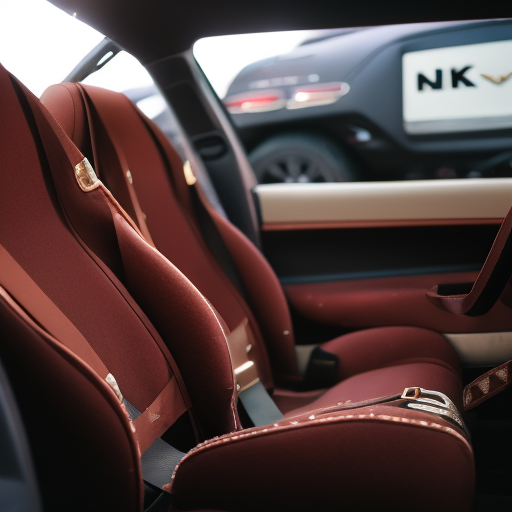
To ensure the safety of your child, it’s important to properly install the car seat. Proper car seat installation is crucial in protecting your child in the event of an accident. Unfortunately, many parents make common car seat installation mistakes that can compromise its effectiveness.
One common mistake isn’t properly securing the car seat to the vehicle. It’s important to carefully read the car seat manual and the vehicle’s owner’s manual to ensure you understand the correct installation process. Additionally, make sure to use the appropriate type of seatbelt or latch system to secure the car seat properly.
Another mistake isn’t tightening the harness straps enough. The harness straps should be snug against your child’s body, with no slack. You shouldn’t be able to pinch any excess fabric between your fingers. This ensures that your child is securely held in place during a collision.
Furthermore, many parents fail to check the recline angle of the car seat. Each car seat has a specific recline angle that must be followed to ensure proper protection. Incorrect recline angles can compromise the safety of the car seat, so it’s vital to double-check and adjust if necessary.
Ensure a Secure Harness Fit
Securing the harness straps tightly is essential for ensuring a safe and snug fit for your child in the car seat. To ensure a secure harness fit, follow these steps:
-
Secure Harness Adjustment:
-
Adjust the harness straps to fit your child snugly. The straps should be flat and lie in a straight line without any twists.
-
Tighten the straps until you can only fit one finger between the harness and your child’s collarbone. This ensures a secure fit and prevents excessive movement during a crash.
-
Proper Chest Clip Placement:
-
Position the chest clip at armpit level. This prevents the straps from slipping off your child’s shoulders and ensures that the force of a crash is distributed properly.
-
Make sure the chest clip is flat against your child’s chest and not twisted. It should be aligned with the armpits, not higher or lower.
Remember, a secure harness fit is crucial for your child’s safety in the car seat. Take the time to adjust the harness properly and double-check the chest clip placement before every car ride.
Position the Car Seat Correctly
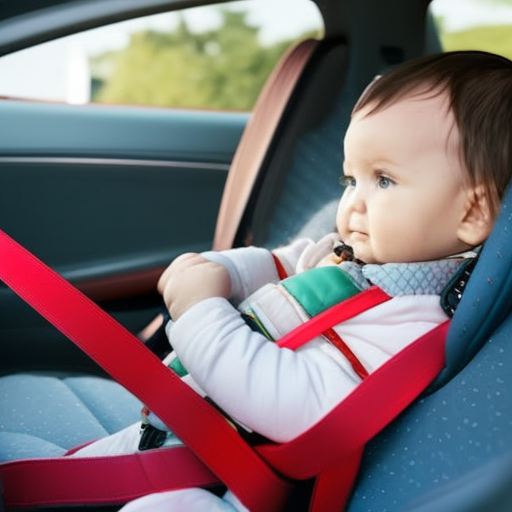
Adjust the positioning of the car seat to ensure a proper fit and maximum safety for your child. Proper positioning is crucial to protect your child in the event of a crash.
One common mistake isn’t reclining the car seat at the correct angle. For infants, the car seat should be reclined at a 30-45 degree angle to support their developing neck muscles.
Another mistake isn’t placing the car seat in the right spot in the vehicle. It’s important to install the car seat in the back seat, preferably in the middle, to minimize the risk of injury. Avoid placing it in front of an active airbag as it can cause serious harm.
Additionally, make sure that the car seat is securely installed using the seat belt or LATCH system. Check for any excessive movement or looseness by firmly shaking the car seat.
Lastly, adjust the harness straps to fit snugly against your child’s body, with the chest clip positioned at armpit level.
Check the Expiration Date of the Car Seat
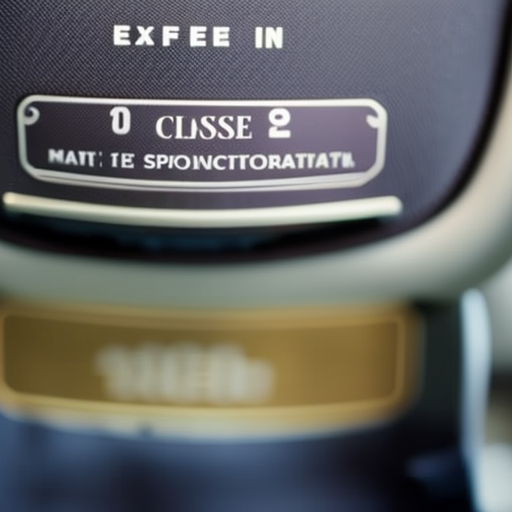
Check the expiration date of your car seat to ensure its safety and effectiveness. Car seats have an expiration date because they’re made with materials that can degrade over time. As a responsible parent or caregiver, it’s crucial to check this date regularly to guarantee that your child is protected in the event of an accident.
Here are some key points to consider when checking the expiration date of your car seat:
-
Check for proper car seat installation: Before checking the expiration date, make sure your car seat is installed correctly. Refer to the manufacturer’s instructions or consult a certified child passenger safety technician for guidance.
-
Position the car seat correctly: In addition to checking the expiration date, ensure that your car seat is positioned correctly. It should be rear-facing for infants and young children until they reach the maximum weight or height limit specified by the manufacturer.
Regularly Inspect for Wear and Tear
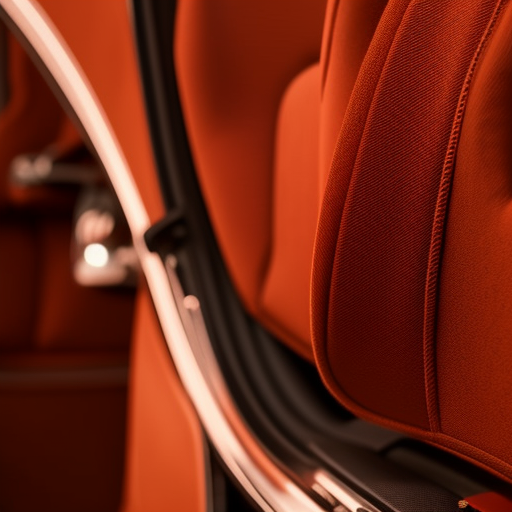
You should regularly inspect your car seat for wear and tear to ensure its safety and effectiveness. Properly maintaining your car seat is crucial in keeping your child secure during car rides. Regular inspections help identify any damage or signs of wear that may compromise the seat’s structural integrity.
Start by visually inspecting the car seat for any visible signs of wear. Look for frayed or worn out straps, loose stitching, or cracks in the plastic shell. Pay close attention to the harness system, making sure it’s still securely attached and functioning properly. Check the padding and fabric for any tears or excessive wear, as this can affect your child’s comfort and safety.
Next, test the car seat’s moving parts, such as the harness adjustment mechanism and the recline positions. Ensure that they’re functioning smoothly and securely. Give the seat a gentle shake to check for any looseness or wobbling that could indicate damage to the base or installation system.
Lastly, consult the manufacturer’s instructions for specific guidelines on inspecting and maintaining your particular car seat model. They may provide recommendations on how often to inspect the seat and any additional steps to take for proper maintenance.
Avoid Bulky Clothing and Accessories
To maintain the integrity of your child’s car seat, it’s important to consider the impact of bulky clothing and accessories. While it may be tempting to bundle your little one up in thick winter coats and cozy blankets, doing so can compromise the effectiveness of the car seat in the event of an accident. Here are some key points to keep in mind when it comes to avoiding bulky winter clothing and choosing appropriate car seat accessories:
-
Avoid Bulky Winter Clothing:
-
Remove bulky coats, snowsuits, and jackets before securing your child in the car seat.
-
Instead, dress your child in thin layers and use a blanket or car seat cover to keep them warm.
-
Choosing Appropriate Car Seat Accessories:
-
Use car seat accessories that are specifically designed for use with car seats and have been crash-tested for safety.
-
Opt for accessories that don’t interfere with the proper fit of the harness straps or the proper positioning of the child in the car seat.
Keep the Car Seat Rear-Facing for as Long as Possible
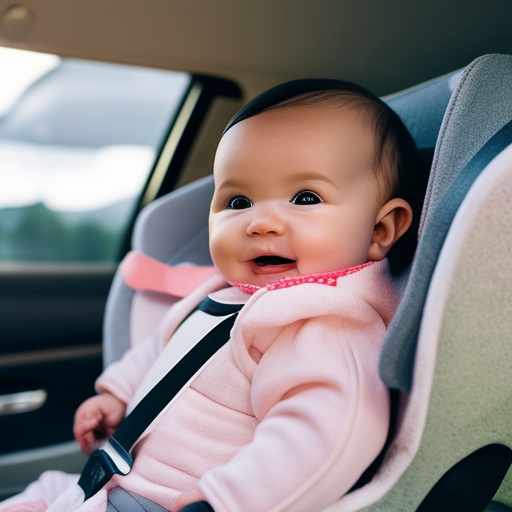
Continue to prioritize your child’s safety by keeping the car seat rear-facing for as long as possible. Extended rear facing benefits are well-documented and can significantly reduce the risk of injury in the event of a car accident. By keeping your child facing the rear of the vehicle, you are providing them with the highest level of protection.
To emphasize the importance of rear-facing car seats, let’s take a look at the following table:
| Rear-Facing Car Seat | Benefits |
|---|---|
| Enhanced Protection | Rear-facing car seats provide better support for your child’s head, neck, and spine, reducing the risk of injury in a crash. |
| Proper Alignment | Rear-facing seats align your child’s body with the car seat, distributing crash forces more evenly and minimizing the impact on their delicate body parts. |
| Age and Weight Limits | Many car seat manufacturers now offer options that allow for extended rear-facing, accommodating children up to 40 pounds or more. |
The benefits of rear-facing car seats are clear. By keeping your child facing the rear for as long as possible, you are ensuring their safety and reducing the risk of severe injuries. Remember, a rear-facing car seat is the best way to protect your child in the event of an accident. So, keep them facing the rear, and give yourself peace of mind knowing you’ve taken every precaution to keep your little one safe.
Use the Top Tether for Forward-Facing Car Seats
Attach the top tether of the car seat to ensure maximum safety for your forward-facing child. The top tether is an essential component of installing a forward-facing car seat correctly. It provides an extra level of stability and prevents the seat from tipping forward in the event of a crash or sudden stop.
Here are some important points to keep in mind regarding the top tether:
-
Importance of the top tether:
-
The top tether significantly reduces the forward movement of the child’s head and neck during a collision.
-
It helps distribute the force of impact across the strongest parts of the vehicle, such as the floor and seatback.
-
Proper installation techniques:
-
Begin by adjusting the top tether to the appropriate length for your vehicle.
-
Locate the top tether anchor point in your vehicle. Refer to the vehicle’s owner’s manual for its exact location.
-
Attach the top tether hook to the anchor point and tighten it securely.
-
Ensure that the top tether strap is straight and not twisted.
-
Double-check that the top tether is securely attached by giving it a firm tug.
Following these proper installation techniques and utilizing the top tether correctly will provide an additional layer of protection for your forward-facing child. Remember, safety is paramount, and every precaution should be taken to safeguard your little one.
Register Your Car Seat With the Manufacturer
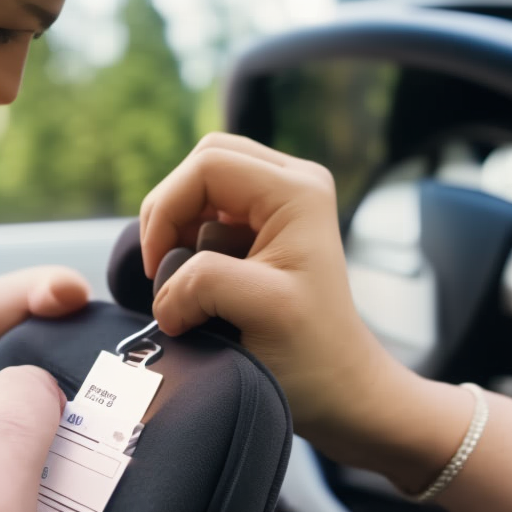
Have you registered your car seat with the manufacturer? Registering your car seat is an essential step in ensuring its safety and staying up-to-date with any important information or recalls. By registering your car seat, you can receive important notifications about any defects or safety concerns, allowing you to take immediate action to protect your child.
One of the benefits of registering your car seat is that it provides the manufacturer with your contact information. In the event of a recall or safety notice, the manufacturer can easily reach out to you to inform you of the issue and provide instructions on how to address it. This ensures that you’re aware of any potential risks and can take appropriate action to keep your child safe.
Registering your car seat is a simple process that can usually be done online or through the mail. When registering, you’ll need to provide the manufacturer with information such as your name, address, phone number, and the model and serial number of your car seat. This information is crucial for the manufacturer to keep track of their products and reach out to you if necessary.
Don’t delay – take a few minutes to register your car seat with the manufacturer today. It’s a small step that can make a big difference in keeping your child safe on the road.
Stay up to Date With Car Seat Safety Guidelines

To ensure the ongoing safety of your child, regularly review and follow the latest car seat safety guidelines. Staying up to date with these guidelines is crucial as they’re constantly evolving to provide the best protection for your little one.
Here are some important tips to keep in mind for car seat installation:
-
Ensure proper installation: Take the time to read the car seat manual thoroughly and follow the manufacturer’s instructions precisely. Double-check that the seat is securely installed and doesn’t move more than an inch in any direction.
-
Positioning matters: Make sure your child’s car seat is installed in the back seat of your vehicle, as it’s the safest place. Additionally, always keep your child in a rear-facing car seat until they outgrow it, as this provides the best protection for their developing neck and spine.
When it comes to car seat usage, it’s essential to be aware of common mistakes that can compromise your child’s safety:
-
Loose harness straps: Ensure that the harness straps are snug against your child’s body, with no slack. You shouldn’t be able to pinch any excess fabric between your fingers.
-
Using an expired or damaged car seat: Check the expiration date on your car seat and replace it if it has expired or been involved in an accident. Additionally, regularly inspect your car seat for any signs of damage or wear and tear.
Frequently Asked Questions
How Often Should I Check for Wear and Tear on My Child’s Car Seat?
You should regularly check for wear and tear on your child’s car seat to ensure its safety. This is important because it can help prevent common mistakes when installing a car seat and maintain cleanliness.
What Should I Do if I Cannot Properly Install My Child’s Car Seat?
If you’re struggling to install your child’s car seat, don’t stress! Seek professional help to ensure their safety. If that’s not an option, consider alternative options like attending a car seat installation event for assistance.
Can I Use a Car Seat That Has Expired?
Yes, using an expired car seat is not safe. Car seat expiration dates are set to ensure they meet current safety standards. It’s important to always use a car seat that is within its expiration date for your child’s safety.
How Do I Know if My Child’s Harness Is Secure Enough?
Is your child’s harness snug enough? Ensure their safety by following these proper car seat installation tips. Double-check that the harness fits properly, holding your little one securely in place.
Are There Any Specific Guidelines for Using Car Seats in Different Types of Vehicles (E.G. SUVs, Trucks)?
When installing a car seat in different types of vehicles, such as SUVs or trucks, it’s important to follow safety guidelines. For sports cars, take extra precautions for secure harnessing. In minivans, ensure proper installation by following tips provided by the car seat manufacturer.
Conclusion
Well, congratulations! You’ve made it to the end of our car seat safety checklist.
You’ve learned all the ins and outs of choosing the right seat, installing it properly, and keeping your little one safe on the road.
Now, armed with this knowledge, you can confidently buckle up and hit the road, knowing that you’ve done everything possible to protect your precious cargo.
Safe travels!


